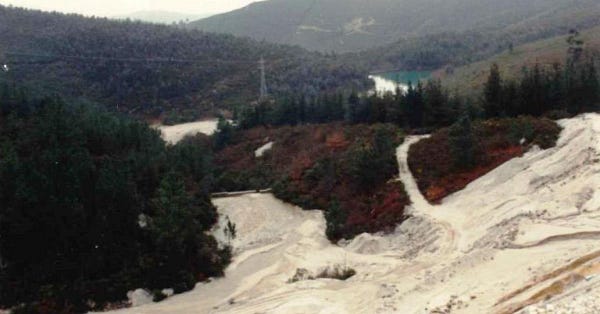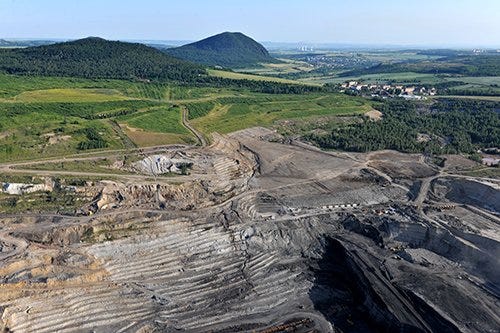September began with an announcement from the European Union that it wanted to mine its own raw materials for clean energy.
The month ended with an open letter signed by 234 civil society organizations and academics urging the EU to rethink its big mining plans. (Patagonia, the cozy coat company, signed it.)
The letter marks environmentalist unease with industrial pathways out of the climate crisis, and it highlights alternatives to a mining-intensive solution. The authors said: We can’t mine our way out of the climate crisis.
The EU’s Raw Material Alliance, launched this week, wants to make sure the bloc’s economy is not undercut by the spiking reliance on metals from the rest of the world.
The world of raw materials is already extremely concentrated. Chile is the biggest producer of both lithium and copper. Platinum metals mostly come from South Africa. Almost all rare earths come from China. If Europe were to build its own battery supply chain, it would have to “start from scratch.”
The EU, like the US, is concerned that this will spell a geopolitical and economic weakness as demand for metals is expected to balloon to levels that already have the mining world spinning. The demand is not only coming from clean energy technologies like EV batteries, but also military technology and internet gadgets like your phone. Wind turbines are the technologies that make it into marketing:


And again like the US, the EU is home to few mines. That’s not a coincidence, as companies in both areas have spent time moving their mines to countries with lower costs, environmental regulation, and visibility. European Commission Vice President Maroš Šefčovič now believes those conditions are justification to halt foreign sourcing of metals. If mines were located in Europe, the argument goes, enforcing sustainability measures would be easier.
Civil society groups, writing in the open letter, are concerned that mining companies in Europe may exploit existing inequalities. For example, community groups in June expressed their strong rejection of a proposed lithium mine in Spain, but the project seems to continue unabated.


The EU’s alliance of investors and miners mentions that “the underlying problem....needs to be addressed by reducing and reusing materials before recycling them.” However, as the letter points out, there is no mention of reducing consumption and the EU’s material footprint in initial plans. Recycling will likely not be able to cover new demand, it reads, and expanding mining isn’t likely to curtail demand, but rather do the opposite.
Civil society groups are also concerned about the current state of mining around the world. The EU sources its metals outside the bloc, but plans say nothing of current policies and practices regarding metal purchases. Until the EU can find its own metals and employ the safeguards it promises, the letter’s authors write, the EU needs to take responsibility for the global supply chains that feed its consumption. (The EU has similarly been trying to enforce sustainable practices in its palm oil demand chain.)
The letter reads:
This is a matter of global justice: it is morally and ethically irresponsible that the EU continues and expands the resource grab, especially from the Global South and from EU enlargement countries, leaving huge environmental and social burdens.
Weekly InQuarry
What does my voice sound like?
Mongabay — a fantastic nonprofit with unique funding to cover conservation, Indigenous peoples, and extractive industries — invited me on its podcast this week.
I joined Catherine Coumans, research and Asia-Pacific coordinator with MiningWatch Canada, to talk about mining and clean energy. If you’ve followed this newsletter for a while, you’ll probably know the stories I mention. But I’d encourage listening for Catherine’s comments on deep-sea mining. I’d also encourage listening if you can’t be bothered to read all these words each week.


I think Catherine brought up an invaluable point: that mining companies are motivated by more extraction and the possibility of inflating revenue while shrinking costs. It’s important that other parties, each with their different motivations, can have their voices heard, too.
You can also listen on Spotify, the Google Podcasts app, Apple Podcasts, Android, Stitcher, TuneIn, RSS, Castbox, or Pocket Casts.
Eye on Industry
The Center for Biological Diversity sued the US Fish and Wildlife Service to speed up and secure a Nevada rare flower on a list of endangered species. The flower mysteriously lost 40% of its population in the last few months. If it’s listed as endangered, the flower may spell the end for a lithium mine.
Tesla and Australia’s Piedmont, a lithium mining company, announced a deal for the car company to buy from the miner’s planned North Carolina mine, 25 miles from the city of Charlotte. The deal represents the first link in a US lithium supply chain, and the farthest that Tesla has made its way up the chain. It plans to process the miner’s concentrate at a proposed plant in Austin, Texas. Similar mines exist in Australia, but few if any are so close to residential areas, and not much is understood about possible impacts from the type of hard-rock mining.


Research from the Sustainable Minerals Institute found that the increased extraction from the energy transition will increase pressure on mining hotspots around the world, and Australia, the US and China will be particularly affected. Co-author Rich Valenta said:
In order to access the increasingly high-risk orebodies necessary to meet this demand, the mining industry needs to prove its environmental and social responsibility to an increasingly conscious public.
There are more than 80,000 inactive mines in Australia (of the total more than 95,000) and only 4% have been rehabilitated, according to recent research.
Reads
RT ≠ endorsement
EVICTING LOTE OCHO: How a Canadian Mining Company Infiltrated the Guatemalan State (The Intercept)
Australia must seize the chance to lead in green steel (The Australian)
Hydrogen Breaks Through as the Hottest Thing in Green Energy (Bloomberg)
‘Every step’ of lithium battery value chain will have an interest in recycling (Energy Storage News)
How the pandemic is delivering the electric truck (E&E News)
Electric Vehicle Demand Will Spark Lithium Mining Reinvention (Bloomberg)
Alternative batteries!
An optimistic – but realistic – perspective for sodium batteries (PV Magazine)
How Eos Energy Storage is contributing to a lower-carbon future (Yahoo Finance)
Hi! I’m Ian Morse, and this is Green Rocks, a newsletter that doesn’t want dirty mining to ruin clean energy.
These topics are relevant to anyone who consumes energy. If you know someone like that, share freely! Subscribe with just your email, and weekly reports with news round-ups and original reporting will come directly to your inbox. It’s free! (for now)






